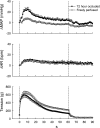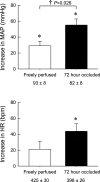Chronic femoral artery occlusion augments exercise pressor reflex in decerebrated rats
- PMID: 20418475
- PMCID: PMC2904125
- DOI: 10.1152/ajpheart.00141.2010
Chronic femoral artery occlusion augments exercise pressor reflex in decerebrated rats
Abstract
In decerebrated rats, we determined the pressor and cardioaccelerator reflex responses to static contraction of hindlimb muscles whose femoral arteries were either occluded 72 h before contraction, occluded 3 min before contraction, or freely perfused. We found that the pressor reflex arising from the limb whose femoral artery was occluded for 72 h before contraction (32 +/- 5 mmHg, n = 16) was significantly higher than the pressor reflex arising from the contralateral freely perfused limb (15 +/- 3 mmHg, n = 16, P < 0.001) or than that arising from the contralateral limb whose femoral artery was occluded for only 3 min (17 +/- 4 mmHg, n = 16, P < 0.001). Moreover, the pressor reflex arising from the limb whose femoral artery was occluded for 3 min before the start of contraction was not significantly different than that arising from the contralateral freely perfused limb (n = 16, P = 0.819). The pressor component of the reflex arising from the limb whose femoral artery was occluded for 72 h was not changed by transient receptor potential vanilloid (TRPV) 1 receptor blockade with iodo-resiniferatoxin (n = 15, P = 0.272), although the cardioaccelerator component was significantly reduced (P = 0.005). In addition, the pressor response evoked by capsaicin injection in the femoral artery of the 72-h occluded limb was more than double that evoked from the freely perfused limb (P = 0.026). We conclude that chronic (i.e., 72 h) but not acute (3 min), femoral arterial occlusion augments pressor reflex arising from contraction of hindlimb muscles and that TRPV1 receptors play little role in this augmentation.
Figures







References
-
- Baccelli G, Reggiani P, Mattioli A, Corbellini E, Garducci S, Catalano M. The exercise pressor reflex and changes in radial arterial pressure and heart rate during walking in patients with arteriosclerosis obliterans. Angiology 50: 361–374, 1999 - PubMed
-
- Bakke EF, Hisdal J, Jorgensen JJ, Kroese A, Stranden E. Blood pressure in patients with intermittent claudication increases continuously during walking. Eur J Vasc Endovasc Surg 33: 20–25, 2007 - PubMed
-
- Crayton SC, Mitchell JH, Payne FC., III Reflex cardiovascular response during the injection of capsaicin into skeletal muscle. Am J Physiol Heart Circ Physiol 240: H315–H319, 1981 - PubMed
Publication types
MeSH terms
Substances
Grants and funding
LinkOut - more resources
Full Text Sources

